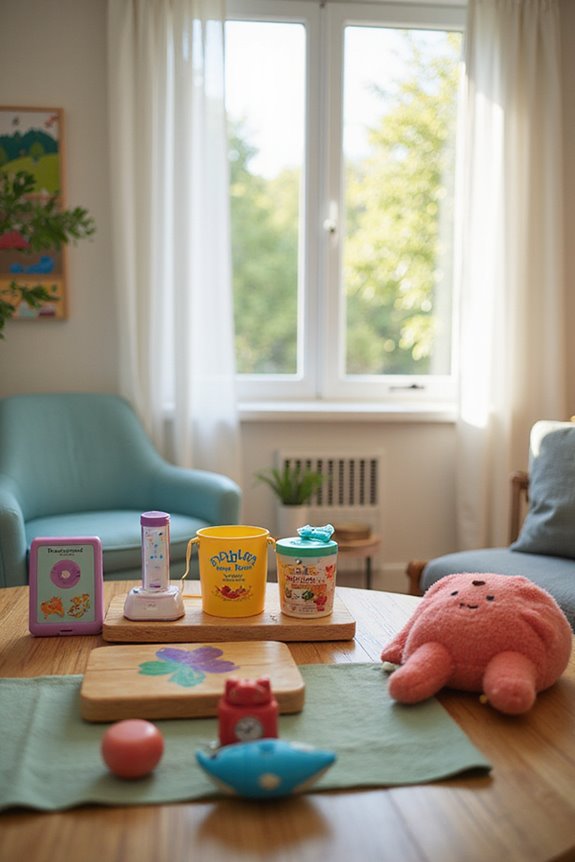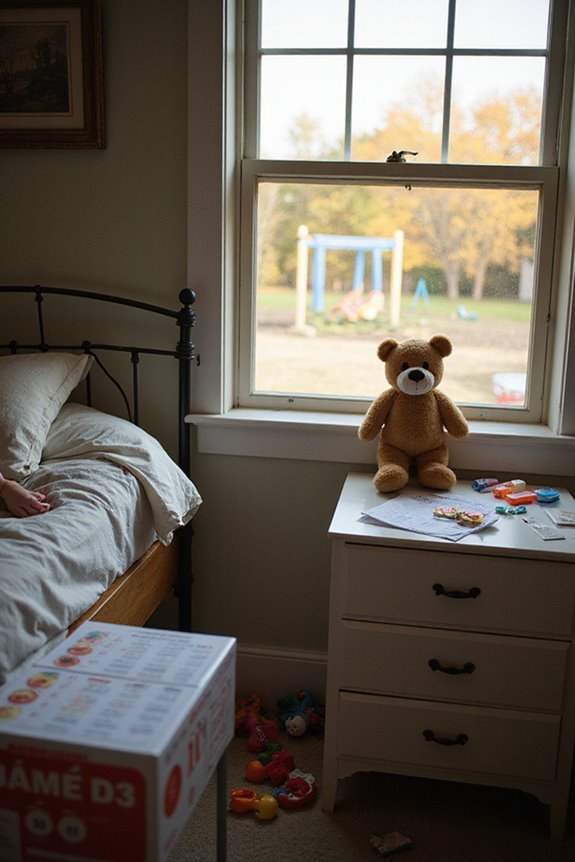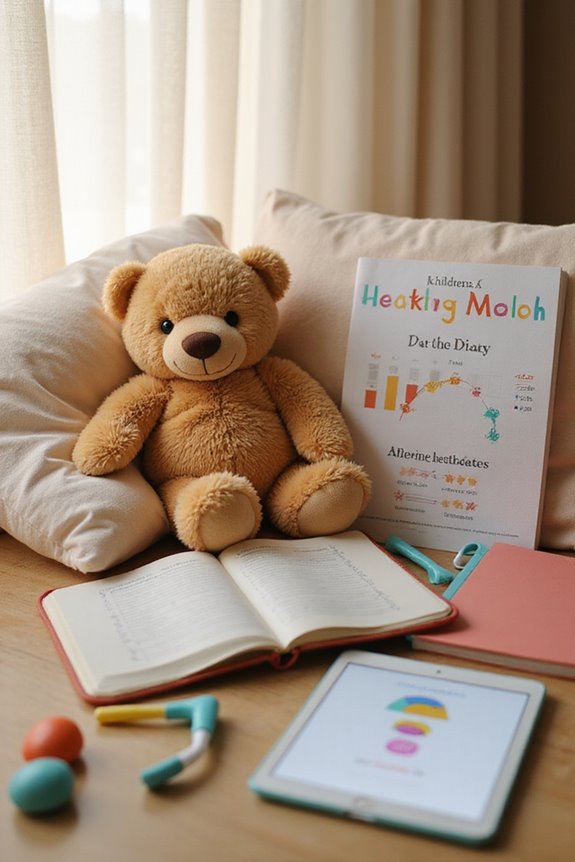Chronic pain markedly hinders child development across multiple domains:
- Prevalence: Approximately 20.8% of youth experience chronic pain, with higher rates in females and adolescents.
- Psychosocial Effects: Emotional distress, including anxiety and depression, can complicate coping and lead to social isolation.
- Cognitive Impact: Chronic pain affects cognitive functions, including processing speed and focus, disrupting daily routines.
Understanding these factors can improve intervention strategies and outcomes. Further exploration reveals more about effective management and support systems.
Key Takeaways
- Chronic pain affects cognitive development, leading to diminished processing speed, working memory, and increased distractibility in children.
- Emotional distress from chronic pain, such as anxiety and depression, complicates social interactions and peer relationships, resulting in social isolation.
- Physical limitations due to chronic pain restrict activities, impacting mobility, fitness, and overall physical health in children.
- Disrupted daily routines from chronic pain hinder normal play, crucial for emotional and physical growth, affecting developmental milestones.
- Long-term effects of chronic pain can lead to mood disorders and poorer quality of life, emphasizing the need for early intervention and support.
Prevalence of Chronic Pain in Youth
Chronic pain in youth presents a significant public health concern, affecting a considerable portion of the pediatric population. Approximately 20.8% of children and adolescents experience chronic pain, with prevalence estimates varying widely from 11% to 38%.
Key points include:
- Chronic pain affects roughly 1 in 5 young people globally.
- Common types include headaches, musculoskeletal pain, and abdominal pain.
- Prevalence is generally higher among females and increases with age, peaking during adolescence.
- Research indicates a need for diverse studies, as most clinical samples mainly reflect Caucasian demographics.
Understanding chronic pain prevalence within youth demographics is essential for effective healthcare interventions. The burden of chronic pain necessitates a multifaceted approach from educational, healthcare, and social systems.
Psychosocial and Emotional Challenges

The presence of chronic pain in youth is often accompanied by significant psychosocial and emotional challenges that can profoundly impact their overall well-being.
- Emotional distress, including anxiety and depression, is prevalent in children with chronic pain, often leading to mood disorders that persist into adulthood.
- Social isolation results from pain, reducing participation in peer relationships and normal childhood activities, which can exacerbate feelings of loneliness.
- The interplay between chronic pain and psychiatric symptoms complicates emotional coping and can hinder psychological resilience.
- Family support plays a critical role, as parental stress and perceptions influence children’s coping mechanisms.
- Interventions targeting family dynamics and emotional health are essential for improving outcomes in affected youth.
Impact on Cognitive and Behavioral Development

- Cognitive dysfunction includes diminished processing speed and working memory capacity.
- Behavioral challenges manifest as increased distractibility and difficulties with focus and decision-making.
- The presence of anxiety and depression further complicates cognitive function and social cognition.
Understanding these interconnections is critical for developing effective interventions that address the cognitive and behavioral complexities resulting from chronic pain, ultimately aiming to improve long-term outcomes for affected youth.
Physical and Functional Limitations

Physical and functional limitations in children with chronic pain greatly hinder their ability to engage in daily activities and achieve developmental milestones.
- Activity Restrictions: Chronic pain leads to significant activity restrictions, affecting mobility and gross motor skills.
- Fitness Decline: Reduced physical activity results in a decline in fitness and muscle strength, contributing to fatigue and endurance issues.
- Caregiver Dependence: Persistent pain often fosters caregiver dependence, limiting children’s independence and self-efficacy.
- Sleep Disturbances: Sleep disturbances exacerbate pain perception, creating a cycle that negatively impacts daily functioning and recovery.
- Developmental Delays: These limitations can lead to developmental delays and reduced social engagement, further affecting overall quality of life.
- Long-Term Risks: Early chronic pain may predict future musculoskeletal weaknesses, highlighting the need for effective pain management strategies.
Family Dynamics and Social Isolation

Chronic pain in children greatly disrupts family dynamics and contributes to social isolation, as the need for ongoing care often reallocates responsibilities within the household.
- Family Role Redistribution: Caregiving burdens shift mainly to parents, leading to increased household stress. Siblings may experience resentment due to unequal task distribution.
- Emotional Strain: Families report heightened conflict and reduced cohesion, with parental distress impacting overall family functioning.
- Social Isolation: Affected children frequently miss social activities, limiting peer interactions. Siblings may feel neglected or burdened by increased responsibilities, while parents prioritize medical needs over family bonding.
These dynamics foster an environment where emotional well-being declines, exacerbating feelings of loneliness and distress within the family unit.
Long-Term Health Outcomes
Long-term health outcomes for children experiencing chronic pain are significant, influencing a range of physical, mental, and emotional domains.
Physical Health Impacts:
- Chronic pain can alter neurotransmitter function, leading to heightened sensitivity and reduced physical activity.
- Ongoing pain may prolong recovery from injuries, affecting overall health trajectories.
Mental and Emotional Outcomes:
- Children with chronic pain face increased risks for mood disorders, which may persist into adulthood.
- Emotional distress from pain can lead to poorer quality of life and hinder coping mechanisms.
Healthcare Utilization:
- Severe chronic pain often necessitates frequent healthcare visits, creating a substantial financial burden on families.
- Early intervention is essential to mitigate long-term effects and reduce dependency on medical services.
Psychological Impact and Mental Health
The psychological impact of chronic pain on children is profound, influencing various aspects of their mental health and overall development.
- Prevalence of Disorders: A significant number of children with chronic pain develop mood and anxiety disorders, with increased vulnerability to posttraumatic stress disorder.
- Risk Behaviors: Chronic pain correlates with elevated risks of suicidal behaviors and substance use.
- Impact on Daily Life: Academic success, school attendance, and social integration suffer due to chronic pain.
- Emotional Regulation: Difficulties in emotional regulation can hinder psychological resilience, leading to further mental health challenges.
- Family Dynamics: The strain on family relationships exacerbates emotional distress for both children and caregivers.
Importance of Early Intervention
Early intervention in pediatric chronic pain is critical for mitigating the adverse effects on a child’s development. Early diagnosis enables timely management, which can prevent functional disabilities, anxiety, and depression.
Key components include:
- Parental Education: Educating parents about pain mechanisms enhances their ability to support their child effectively.
- Psychological Strategies: Early implementation of evidence-based interventions, such as Cognitive-Behavioral Therapy, normalizes children’s activities and improves outcomes.
- Functional Rehabilitation: Focus on restoring daily activities, rather than solely symptom relief, promotes overall well-being.
- Collaborative Programs: Emphasizing parent-child collaboration yields stronger effects on pain reduction.
Recognizing chronic pain as a significant condition is essential for healthcare providers, ensuring families receive integrated support early in the process.
Strategies for Managing Chronic Pain in Children
Effective management of chronic pain in children requires a multifaceted approach that incorporates various strategies tailored to the individual needs of each child.
Non-Pharmacological Therapies
- Physical therapy enhances function and reduces pain.
- Cognitive-Behavioral Therapy (CBT) reframes pain perception.
- Biofeedback teaches control over pain-related physiological processes.
Integrative Strategies
- Art and music therapy provide emotional expression and distraction.
- Therapeutic recreation maintains normal routines through play.
Family and Behavioral Approaches
- Family counseling addresses dynamics impacting pain.
- Activity scheduling balances rest and activity to prevent fatigue.
Psychological Support
- Mindfulness and relaxation training promote self-regulation.
- Social support groups facilitate peer interaction and shared experiences.
These strategies collectively enhance pain management and support development.
Frequently Asked Questions
Can Chronic Pain in Children Affect Their Physical Growth and Development?
Chronic pain in children can lead to growth restrictions and developmental delays. Physical limitations hinder participation in activities essential for healthy growth, while associated emotional challenges further complicate their overall developmental trajectory and well-being.
What Role Do Schools Play in Supporting Children With Chronic Pain?
Schools play a crucial role in supporting children with chronic pain by fostering accommodating environments and providing educational support. Tailored interventions and staff training enhance awareness, helping students feel included and understood in their learning journeys.
Are There Specific Types of Chronic Pain More Common in Children?
In children, specific chronic pain types include abdominal migraines, juvenile arthritis, and fibromyalgia symptoms. Additionally, complex regional pain syndrome emerges, highlighting the diverse experiences of pediatric chronic pain and the need for tailored support strategies.
How Does Chronic Pain Impact a Child’s Friendships and Peer Relationships?
Chronic pain greatly impacts friendship dynamics, often leading to social isolation. Children may struggle to form connections, experience stigmatization, and withdraw from peers, ultimately affecting their sense of belonging and emotional well-being in social environments.
What Resources Are Available for Families Coping With a Child’s Chronic Pain?
Steering through the stormy seas of chronic pain, families can find solace in support groups and online resources. These platforms offer guidance, community, and valuable information, fostering connections that help them weather the challenges together.





